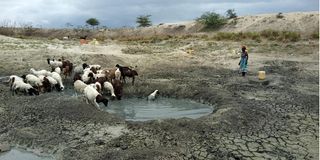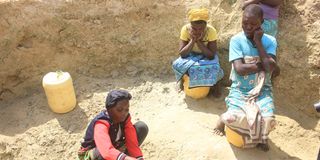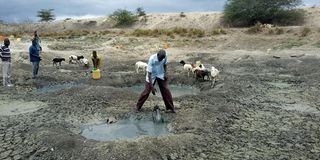Premium
Humans, wildlife fight for water and pasture in Kwale, Taita Taveta and Kilifi counties

Sheep drink dirty water at the Dingiria water pan in Ganze, Kilifi County.
The fight for scarce water and pasture between humans and wildlife is becoming more protracted in Coast region amid a biting drought.
Wild animals foraging for pasture and water in Kwale, Taita Taveta, and Kilifi counties continue to stray into villages, setting the stage for a major conflict.
Several people and livestock have been killed or maimed by the animals.
In Kwale County, which neighbours the vast Tsavo National Park, elephants roam freely in villages. Residents have complained that the Kenya Wildlife Service (KWS) is doing little to avert the threat.
Kinango, Samburu, and Lunga Lunga are the most affected, where at least 200,000 residents are at risk of starvation.
Some of the residents have been injured during encounters with elephants as they have to walk long distances in search of water.

A woman fetches water from the drying Dingiria water pan in Kilifi County.
Last Sunday, locals killed a leopard that had attacked their village in Samburu, Kwale County. Two people were injured and were admitted to Samburu Sub-county Hospital during the incident.
Mr Chirimani Bembeyu, 52, was attacked as he walked to Samburu town. He was injured on the head, leg, and hand. Mr Tsuma Lalo (19) was the other victim of the leopard attack.
Samburu Sub-county Police Commander Fred Ombaka said the leopard invaded the village at 6am and was spotted by women who were searching for water.
“They raised the alarm and armed residents came to their rescue. But by the time they had killed the leopard, it had already injured two men,” said Mr Ombaka.
He advised residents to report such incidents to the authorities instead of killing the wild animals, whose lives are also endangered by the drought.
“We understand that the animals are straying from national parks because of the harsh climate conditions. Residents should be careful not to take matters into their own hands, but report to the authorities first,” Mr Ombaka said.
He asked the KWS to intervene and help monitor and control the animals to prevent them from getting into villages.

Woman are the hardest hit by the drought in Ganze, Kilifi County.
Elephant invasions have been reported in other dry parts of Kwale County.
In areas like Mariakani, residents have reported that herds of elephants are freely roaming the streets in search of water.
According to the KWS, cases of human-wildlife conflict have risen because of the harsh conditions in the Tsavo.
So bad is the situation that, since the beginning of the year, 179 elephants and 200 Somali giraffes have died, according to outgoing Tourism and Wildlife Cabinet Secretary Najib Balala.
Kwale KWS Senior Warden Jacob Orale said wild animals are moving away from Tsavo on the migratory corridor to northern Tanzania.
“Drought conditions have affected our wild animals and they are now roaming villages looking for water and pasture. However, we have deployed more wardens to save the situation,” he said.
In the past three months, elephants have attacked residents in Lunga Lunga. Locals, such as Mr Benson Mutinda, a farmer, are living in fear as they count their losses from destroyed tomato, kale, and sorghum crops.

A man helps pull a goat stuck in the muddy Dingiria water pan in Ganze, Kilifi County.
“The situation is getting worse by the day. We hope that it rains soon so that the animals can go back to their natural habitat,” said Mr Mutinda.
Incidents of leopards invading villages and attacking livestock have been reported in Voi, Taita Taveta County, which shares a border with Kwale County.
Last year, a hyena was killed after it attacked several villagers and ate two babies.
Ranchers in Taita Taveta County have asked KWS to allow them to graze their livestock inside the Tsavo National Park.
They said they have lost their herds to the famine and would incur more losses if nothing is done.
Taita Taveta Wildlife Conservancies Association Chairman Mcharo Bong’osa, who made the request on behalf of the ranchers, asked KWS to open up special grazing areas inside the park to save the animals.
Mr Bong’osa said pasture in ranches has deteriorated due to significant rainfall deficits in the past two years.
“All pasture and water in our area have been depleted because we share them with wildlife,” he said. He asked leaders from the national and county governments to convene a meeting with other stakeholders to come up with a drought response strategy aimed at providing immediate and short-term solutions.

Ms Taaabu Kahindo Gogo from Dingiria village in Ganze, Kilifi County lost 20 cows to drought last month.
The Wildlife Conservation and Management Act 2013 allows grazing in wildlife parks, but the Department of Wildlife is yet to make guidelines on accessing protected areas for purposes of grazing and watering livestock during drought seasons and natural disasters.
“We are losing our herds due to the crippling drought which has led to the drying up of reliable water sources. All the water pans in our ranches have dried up. If nothing is done in the next two weeks, it will be disastrous for our animals,” Mr Bong’osa said.
According to the National Drought Management Authority’s situation report for October, 144,000 cows, 51,885 sheep, and 386,832 goats have been affected by the drought.






